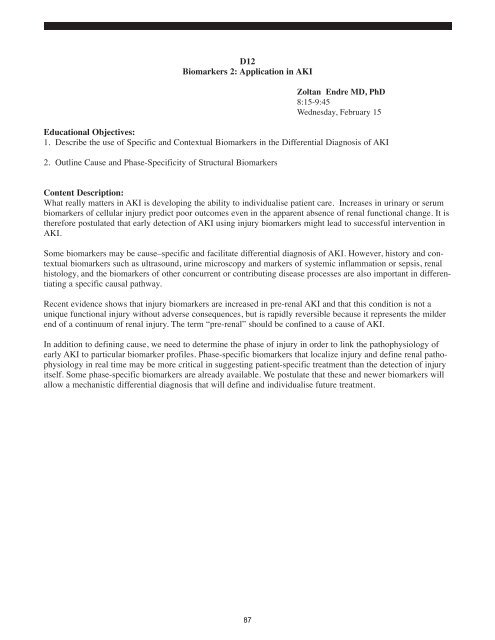ABSTRACTS from 16th International COnference on ... - CRRT Online
ABSTRACTS from 16th International COnference on ... - CRRT Online
ABSTRACTS from 16th International COnference on ... - CRRT Online
You also want an ePaper? Increase the reach of your titles
YUMPU automatically turns print PDFs into web optimized ePapers that Google loves.
D12<br />
Biomarkers 2: Applicati<strong>on</strong> in AKI<br />
Zoltan Endre MD, PhD<br />
8:15-9:45<br />
Wednesday, February 15<br />
Educati<strong>on</strong>al Objectives:<br />
1. Describe the use of Specific and C<strong>on</strong>textual Biomarkers in the Differential Diagnosis of AKI<br />
2. Outline Cause and Phase-Specificity of Structural Biomarkers<br />
C<strong>on</strong>tent Descripti<strong>on</strong>:<br />
What really matters in AKI is developing the ability to individualise patient care. Increases in urinary or serum<br />
biomarkers of cellular injury predict poor outcomes even in the apparent absence of renal functi<strong>on</strong>al change. It is<br />
therefore postulated that early detecti<strong>on</strong> of AKI using injury biomarkers might lead to successful interventi<strong>on</strong> in<br />
AKI.<br />
Some biomarkers may be cause–specific and facilitate differential diagnosis of AKI. However, history and c<strong>on</strong>textual<br />
biomarkers such as ultrasound, urine microscopy and markers of systemic inflammati<strong>on</strong> or sepsis, renal<br />
histology, and the biomarkers of other c<strong>on</strong>current or c<strong>on</strong>tributing disease processes are also important in differentiating<br />
a specific causal pathway.<br />
Recent evidence shows that injury biomarkers are increased in pre-renal AKI and that this c<strong>on</strong>diti<strong>on</strong> is not a<br />
unique functi<strong>on</strong>al injury without adverse c<strong>on</strong>sequences, but is rapidly reversible because it represents the milder<br />
end of a c<strong>on</strong>tinuum of renal injury. The term “pre-renal” should be c<strong>on</strong>fined to a cause of AKI.<br />
In additi<strong>on</strong> to defining cause, we need to determine the phase of injury in order to link the pathophysiology of<br />
early AKI to particular biomarker profiles. Phase-specific biomarkers that localize injury and define renal pathophysiology<br />
in real time may be more critical in suggesting patient-specific treatment than the detecti<strong>on</strong> of injury<br />
itself. Some phase-specific biomarkers are already available. We postulate that these and newer biomarkers will<br />
allow a mechanistic differential diagnosis that will define and individualise future treatment.<br />
87
















